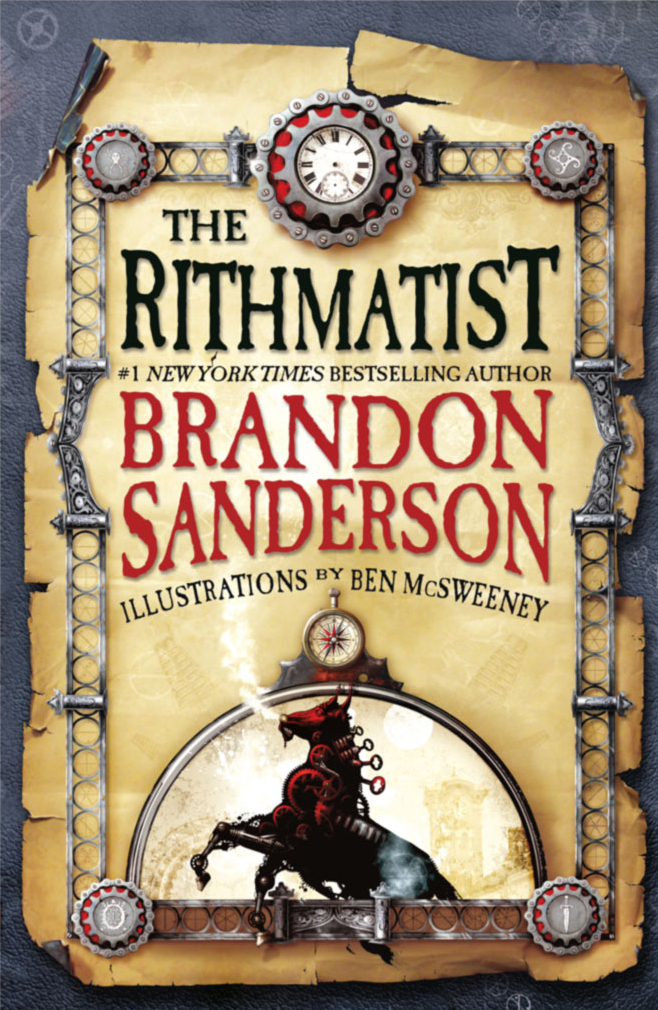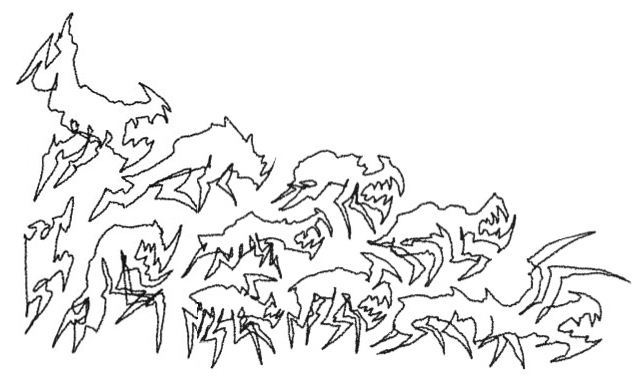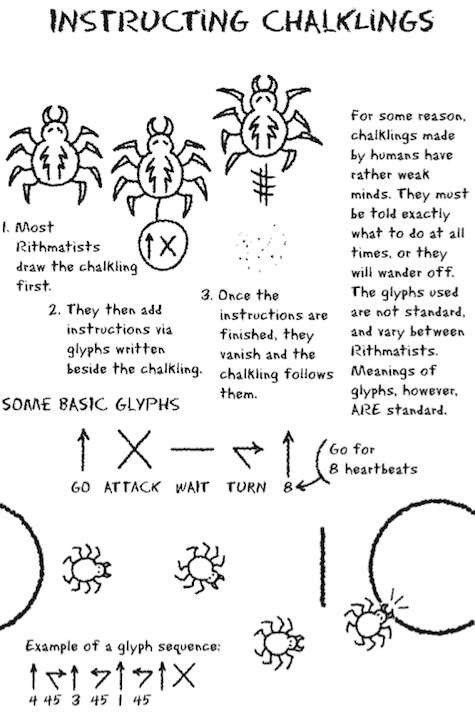In 2011 I attended a convention at which Brandon Sanderson was the guest of honor. During one of the talks he gave, he described some of his upcoming projects, one of which was his upcoming YA novel The Rithmatist, coming out on May 14th from Tor Teen.
He described it as a magical, chalk-based real time strategy game, a concept that hooked my interest immediately. At first blush I assumed that this comparison was being made on the back of the monstrous threat to the Rithmatist universe: wild Chalklings, sentient chalk drawings that can rend human flesh, and which scurry and swarm in a manner that quickly draws to mind the Zerg from StarCraft. That being said, when I read the novel I found myself surprised by how deeply the comparisons between Rithmatists and high-level RTS players are, beyond just the Chalkling/Zergling analogy. The result of this is a class of hero very different from Sanderson’s standard, and I’d like to explain why, with reference to my extreme layman’s understanding of Starcraft 2, and the underlying strategies of it and other RTS games.
RTS games, for those who’ve never played one, are games that center around the building up of an army, and the economy necessary to support one, from essentially nothing. Players then try to maneuver those armies to attempt to wipe out their opponents. The most popular RTS games are StarCraft and its sequel StarCraft 2, and they have together long formed the foundation for the international e-sports scene. This genre is notable for the extreme mental requirements put forth on its players. StarCraft 2 demands that the player concentrate simultaneously on maneuvering huge armies of many different types of units and on maintaining and growing a robust economy to provide reinforcements and upgrades. It’s not easy. But how can an experience like this, which is so much about handling little details over a long span of time, translate into a compelling fantasy novel? What does it even mean to write a novel about an RTS? Well, it comes down to the two skillsets that you need to be good at StarCraft: Macro and Micro.
Macro: “Spawn more overlords!”
Spawn more overlords. Construct additional pylons. Insufficient Vespene gas. These are the sound bites that StarCraft veterans may have come to dread, and they all represent a failure to keep up with their macro. Good macro play means having enough money when you need it, making sure you can support the units you have and that you have enough supplies to grow your forces, etc. But in the simplest terms it means having a solid foundation, and being equipped to play the long game.
 The first choice that a Rithmatist has to make in any given battle is what defense they’re going to rely on. Defenses are composed of a circle or an ellipse, each of which can have a certain number of points of attachment, anchored in place by Lines of Forbiddance. The more lines you draw, the more firmly anchored your circle will be, and the harder it will be for a rival Rithmatist to displace you or for wild chalklings to break in and mess you up. However, once you’ve drawn a Line of Forbiddance, you can’t cross it, at all. The stronger your defense, the more tightly you’re bound. Which leads to a number of different strategies.
The first choice that a Rithmatist has to make in any given battle is what defense they’re going to rely on. Defenses are composed of a circle or an ellipse, each of which can have a certain number of points of attachment, anchored in place by Lines of Forbiddance. The more lines you draw, the more firmly anchored your circle will be, and the harder it will be for a rival Rithmatist to displace you or for wild chalklings to break in and mess you up. However, once you’ve drawn a Line of Forbiddance, you can’t cross it, at all. The stronger your defense, the more tightly you’re bound. Which leads to a number of different strategies.
The first Rithmatic duel in The Rithmatist is, in the end, decided by the fact that the defending Rithmatist chose far too conservative and rigid a defense. His opponent overwhelms him with an aggressive, early-game strategy. If he had defeated the first few waves of attacks, however, and settled into a longer battle of attrition, he would have been excellently positioned with a resilient defense. Additionally, the more complex your defense is, the more time it will take to draw, and the longer it will take you to go on the offense. Many a Rithmatist had fallen to chalklings while attempting to make a nine-point circle, just as many an innocent player has been defeated by an overwhelmingly early zergling rush. (Kekeke, as it were.)

Micro: “Our forces are under attack!”
The other half of the game is micro, the art of managing the units on the ground skillfully. Sure, it’s possible to just select your entire army and give it its marching orders to the other side of the map. Go forth, my hundred marines, go forth and shoot anything that gets in your way! Of course, if you do that, and the other person pays more attention and orders his units to, for example, back up in the face of the initial push and then surround the enemy in a pincer… well. That’s going to be a sad day for the marines. The player with superior micro will win any otherwise equal engagement, and a player with EXCEPTIONAL micro can turn a macro-disadvantaged situation around and seize victory.
This is exactly the situation that Joel, our young hero, recounts having happened at the 1888 Melee:
“Paul Chew and Adelle Choi are the only two duelists left. Adelle survived, against all odds, after her entire team was picked off in the first few minutes… Paul’s team had shielded him at their center so that the lesser players fell first. They knew that would get him to the end practically fresh, his defensive circle almost completely untouched.”
Paul has the macro advantage: his defensive circle is pristine, while his opponent’s is worn down. He has been preparing for this moment, while she has been desperately fending off assaults. But, then she manages something incredible:
“She saw something. Paul had a small weakened section at the back of his circle. Of course, the only way to attack it would be to bounce a shot off three different lines left by other duelists. It was an impossible shot. She took it anyway.”
And, of course, like all million-to-one shots, it worked out. Excellent reflexes, focuses, timing and aim all combine into a skill that can bring a superior army to its knees.
Brandon Sanderson is no stranger to exciting and magical combat. Both Mistborns and the gravity-defying Surgebinders of The Way of Kings have to think in three dimensions, using every element of their surroundings to their advantage to win against overwhelming odds. And that is thrilling, and I love it. But by taking his inspiration from a very different source, by learning from StarCraft rather than Star Wars, I think that Sanderson has created a much more interestingly nuanced sort of combat.
A successful Rithmatist just has to be good at so many different kinds of thinking! He or she not only has to be fast and strong, but also smart, quick-witted, good at thinking many steps into the future, reading the opponent, quickly shifting strategies to counter those being used against him or her, and capable of drawing a near-perfect freehand circle under duress. It’s truly a thinking person’s style of flashy magical combat.
The Rithmatist is out on May 14th from Tor Teen. Read the first six chapters for free.
Carl Engle-Laird is the production assistant for Tor.com and a rereader of The Way of Kings. You can read more of his Sanderson-related writings here, or follow him on Twitter. He is not good at StarCraft.










